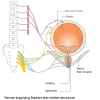Introduction
Urinary incontinence is defined as the involuntary loss of urine. There are many different reasons why this may occur. Leakages may range from just a few drops to a stream. It can impact one’s life significantly by:
- Limiting your activities.
- Keeping you homebound.
- Costly, messy pads.
- Frustration and embarrassment.
- The constant fear of leaking and odour.
However, there are still many people who choose to ‘live with it’ and never seek any medical attention. This is certainly regretful as urinary incontinence is very much a treatable condition nowadays.
How common is Urinary Incontinence?
In an Australian survey, 301 (24%) of 1256 respondents – 13% of the male and 33% of the female respondents – had some degree of urinary loss. A staggering 70% of the people with leakage had never sought medical help. Of those who do, about a quarter would wait 5 years before doing so. Those with more severe incontinence and those over 60 years of age were more likely to seek help.
The estimated prevalence of incontinence in women is:
- 19% of women in the 10 – 29-year-old group.
- 39% of women in the 30 – 44-year-old group.
- 50% of women in the 45 – 59-year-old group.
- 30% of women in the 60 – 74-year-old group.
- 43% of women in the 75+ age group.
This trend is accentuated after 30 years of age, possibly as a result of pregnancy and childbirth.
The prevalence in men is:
- 10% of men in the 10 – 29-year-old group.
- 13% of men in the 30 – 44-year-old group.
- 13% of men in the 45 – 59-year-old group.
- 21% of men in the 60 – 74-year-old group.
- 44% of men in the 75+ age group.
Incontinence becomes more common as men age, mainly because of prostate-related causes.
How does the bladder work?
The average urine output per day is 1.5 – 2.5 litres. Most people feel the urge to pass urine when there is about 200 – 400ml in the bladder. The normal bladder capacity is about 500ml. The wall of the bladder is elastic and can expand with urine, without a rise in the pressure within.
To ensure continence, the bladder must have an intact sphincter, pelvic floor support and a normal nerve pathway (‘electrical wiring’) between the brain and the bladder.
The sphincter is a ring of muscle around the neck of the bladder that acts like a tap. In normal situations, this ‘tap’ remains closed to prevent urine leakage. During voiding, the ‘tap’ then relaxes and lets urine through. In men, the sphincter may be damaged during prostate surgery.
The pelvic floor is made up of muscles and ligaments and is located at the base of the bladder. This acts as a ‘trampoline’ that supports the bladder and prevents leakage. In women, the pelvic floor may be damaged from vaginal childbirth.
When a bladder stretches with urine, it sends signals to the brain, which in turn sends inhibitory signals back to the bladder, telling it to hold the urine in. During voiding, the brain consciously relaxes the sphincter and pelvic floor to allow the bladder contraction to empty the bladder. This nerve pathway may be interrupted in some individuals – see neurogenic bladder.
Common types of urinary incontinence
The most common types of incontinence are:
Stress incontinence
Leakage occurs during physical activities like laughing, exercising, and sneezing. The management differs in women (female stress urinary incontinence) and men (post prostatectomy urinary incontinence).
Urge incontinence
Leakage occurs when the urge to urinate is so strong that a person cannot make it in time to the toilet. This is usually associated with an overactive bladder (OAB).
Mixed incontinence
A combination of stress and urge incontinence.
Overflow incontinence
Leakage is usually associated with an underactive bladder or a bladder that does not completely empties. Characterised by continuous dribbling throughout the day.
Uncommon types of urinary incontinence
There are other more uncommon types of urinary incontinence. Some examples are:
Functional incontinence
Due to one’s physical inability to get to the toilet (e.g., bed-bound patients, with Parkinson's) or lack of awareness (e.g., patients with dementia).
Poor bladder compliance
Due to a ‘stiff’ bladder, which does not stretch during bladder filling. The pressure within the bladder rises gradually until leakage occurs. This can potentially cause back-pressure up to the kidneys and result in kidney damage.
Post-void dribbling
In women, this can be due to the pooling of urine in the vagina or in a urethral diverticulum (small pouch in the water channel draining the bladder).
More common in men. This can be due to benign prostatic enlargement causing incomplete bladder emptying.
Continuous and constant leakage
This can be due to an abnormal connection between the urinary tract and the vagina (fistula). A congenital condition in which the ureter (the tube that drains the kidney) can come down and open in another site other than inside the bladder – ectopic ureter.
Diagnosis
The following survey tool acts as a starting point to help diagnose patients who suffer from the most common types of urinary incontinence.
|
Questions |
Stress |
Urge incontinence |
Mixed incontinence |
Overflow incontinence |
|
Do you leak when you sneeze, cough, jump, lift heavy objects? |
Yes |
No |
Yes |
Sometimes |
|
Do you often get strong urges to pass urine that you cannot defer? |
No |
Yes |
Yes |
No |
|
Have you not made it to the toilet in time? |
No |
Yes |
Yes |
No |
|
Do you get strong bladder urges when you put the key in the front door? When you hear a running tap? |
No |
Sometimes |
Sometimes |
No |
|
Do you go to the toilet 8 times during the daytime? |
No |
Mostly |
Mostly |
No |
|
Do you wake up more than once to pass urine at night? |
No |
Mostly |
Mostly |
No |
|
Do you leak urine overnight even if you don’t wake up? |
No |
Sometimes |
Sometimes |
Yes |
|
Are you often unaware when leakage would occur (no warning)? |
No |
No |
No |
Yes |
|
Do you have a less need or sensation to void compared to other people? |
No |
No |
No |
Yes |


